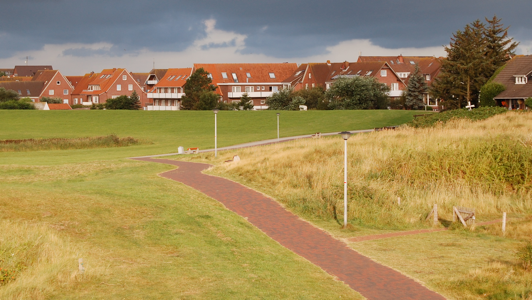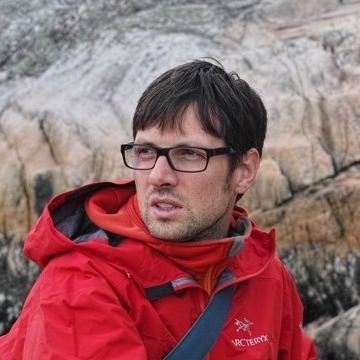Baltrum, a car-free island community
Our car culture is one alternative, others work fine too.
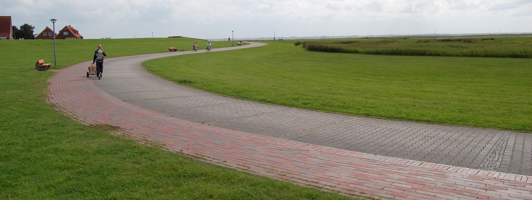
As you leave behind a car park and, after a 40 minute ferry trip, arrive to a much more peaceful wagon park, the car-free contrast is jarring. Not only is the setting calmer but the people have also relaxed. No one is in a rush to find parking, get luggage from the car, get on the ferry before it leaves. Each family walks down the rows of wagons looking for the one with their house number on it. These transport wagons sport a hitch to be mounted behind a bike but also two hand grips so they may be hand-pulled. These wagons are large enough to fit a couple large suitcases and some tired children. So begins the walk from the ferry terminal into town and to our rental home. The ferry traffic quickly spreads down the road as those with bikes or in horse taxis pull ahead.
Located in the north sea just off the coast of the German mainland is one of a few car-free community islands named Baltrum. Now just because Baltrum island is a car-free community doesn’t mean there exists no sidewalk. The street stones are of different colours to indicate fast and slow traffic areas. Only on the main strip to the ferry terminal during loading/unloading will you get the critical mass where staying to your lane is encouraged. Cyclists kindly ring their bells to warn you before passing by with their loaded trailers.

You do not notice it during the first days explicitly but your perception of safe space quickly encompasses everything around you, with perhaps the exception of some prickly bushes. Having children changes your perception of space. A periphery of safety is constantly evolving as you move through urban spaces. The distance between you and your children must always be adequate so that if a child decides to bee-line for a road, cliff or animal, you can reach them in time. This distance evaporates in this sandy car free community. Having your children sit on the pavement or walk into the fields over a hundred metres from you is no cause for concern. The last time I felt this same sensation of total safety was in the middle of Berlin at the former Tempelhof airport.
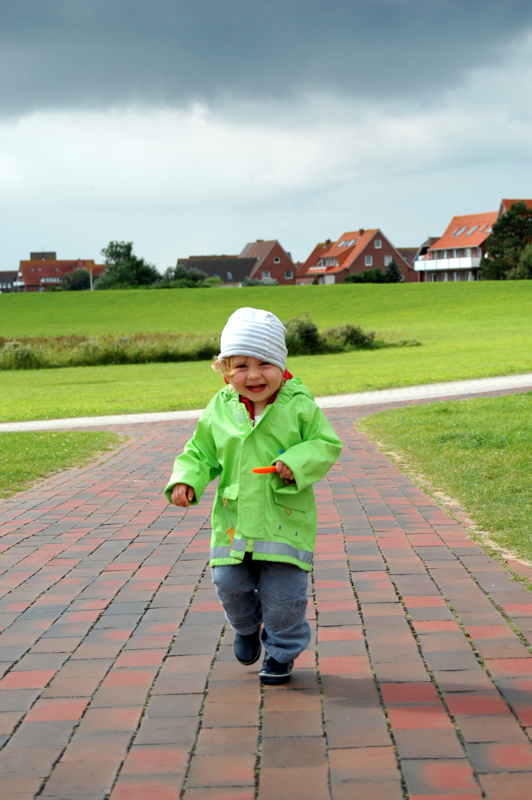
Baltrum is a fully functioning community all year round. The popularity of the island surges during the summer months but about 500 people live there permanently. There is a school, shops, restaurants, cafes and ice cream parlors.

They have a wonderfully heated salt water swimming pool that is great for getting skinny kids to spend more than ten minutes in the water without freezing. How all these services coordinate food delivery and waste disposal is through bike and horse drawn wagons. This maintains the peaceful nature of the island. In addition horses add great charm.
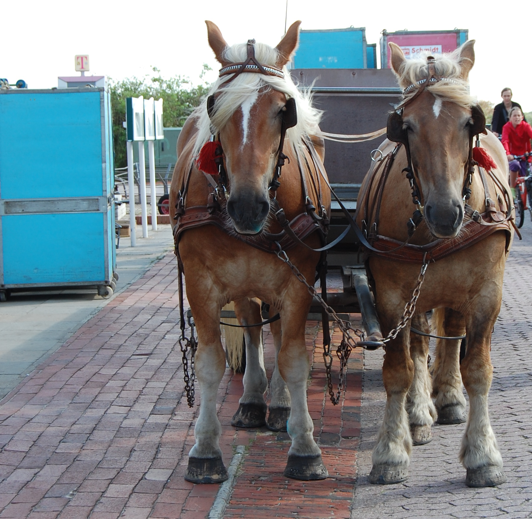
Having a zero-tolerance for cars absolutely makes a difference for a community. I have spent a week at Savary Island, another island labeled as car-free along British Columbia’s sunshine coast, and never felt the same peace that I did at Baltrum.
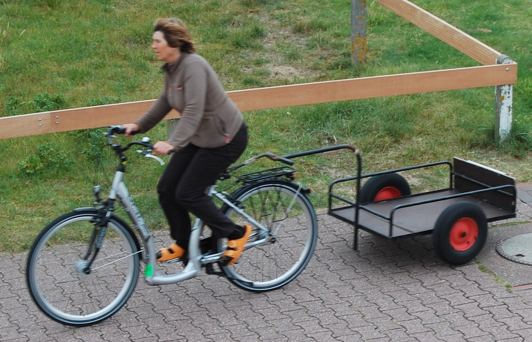
People adjust to the car-free lifestyle through the use of trailers. All the locals have hitches to attach trailers to their bikes.

This makes attaching your trailer filled with garbage to the waste centre a snap.

Besides moving personal goods, businesses also adapt. Mail delivery is done through electric bikes with custom oversize baskets and trailers. I assume living on an island with a narrow selection of goods encourages online shopping.
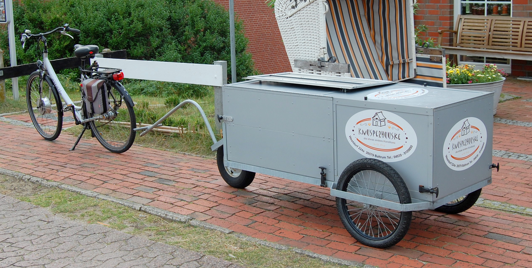
There are two distinct types of trailers. Those for bikes, which can also be pulled by hand, and those specifically for walking with chubby tires for beach access.
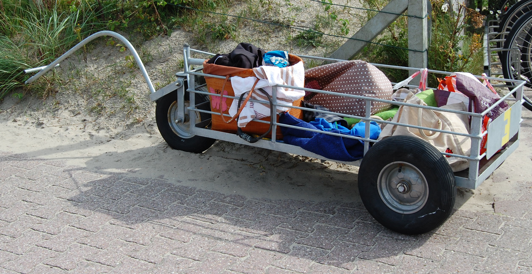
Many people use the hand-pulled wagons for shopping errands.
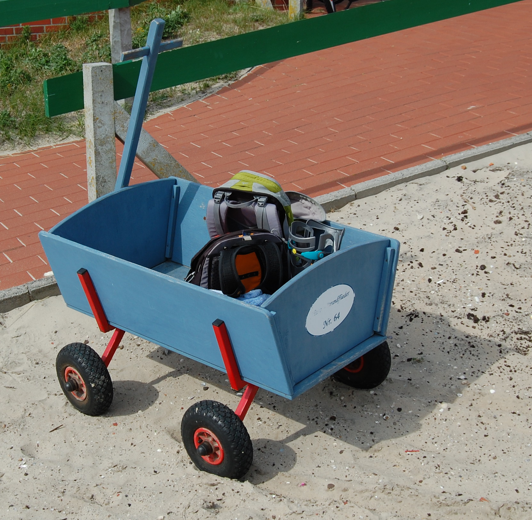
The beach wagons are great for going to the bakery, beach or ice cream parlor with the kids though. We went for some wonderful walks through the marshes and across dunes with the kids being content hoping in and out of the wagon at will. You can achieve a lot more by buying some good German pretzels and giving your kids a snack while getting to your destination. There’s no being buckled and all facing forward or stuck in traffic. There’s no anonymity. Every person you pass has a face, a mood.

Baltrum is more than a holiday destination, it is also a health resort. The coast is renowned for its health benefits. The fresh air draws in large retired populations. The cycling nature of the island also largely help people maintain their physical health. Many of the locals have electric bikes to help with daily trips about the island.

I do not recall what I expected from Baltrum before visiting. I did not anticipate the complete peacefulness I experienced there with the kids. Car-free streets destroy the social and physical barriers separating people. It is socially unaccepted to communicate between automobiles, nor is it easy to accomplish in anything but nice weather at slow speeds. Cyclists experience a different reality. Cyclists can meet, merge and talk as they head off together. Something that is impossible to do with cars. The (re)creation of streets as enjoyable spaces where foul-smelling cars are not loud and zipping by dangerously affords people the opportunity to slow down, chat with strangers and sit anywhere you (or your kids) please. I am quite strongly convinced that such a community can exist within a larger city as well. While densities would increase it does not decrease feasibility.
The strongest argument for car-free communities is kids but we all win. Creating safe spaces allows children to go out alone and play, meet other friends, travel to a friend’s house. Children can spend time safely outdoors without causing their parents to fret. Children can learn more about their world, the environment, animals, bugs and birds. The decline of children in the streets has reduced the healthy social interactions that develop individuality and character.
With children spending more time outside the house parents can return to completing personal hobbies and socializing with people of similar intellect. Maybe even question discuss policies and politics. This richness of socializing encourages healthier and happier families that greater value the time they do spend together. As children meet new friends these can create new parental connections as well. Car-free communities encourage socializing directly but this is a feedback loop of increased socialization. The more people you know the more new connections you can potentially meet. I am not talking about Facebook friends. Car-free societies have the possibilities to create rich vibrant societies based on individuals who are happier due to the decreased isolation present in our existing society. The wealth of media and ‘social’ networking activities that surround us only allow stronger isolation due to their superficial natures. Society is driven to consume goods, ‘facts’, advice and news which makes individuals and families stagnate socially. Should we not be doing more to revitalize our lives and our society? Car-free communities can do this. We can do it for our own health but we should do it for the kids.
